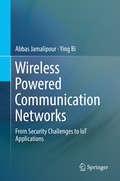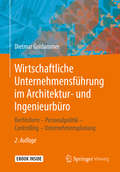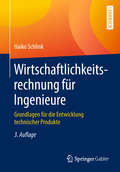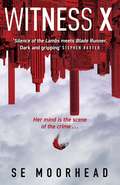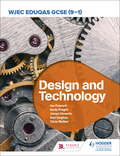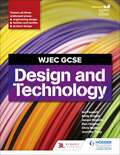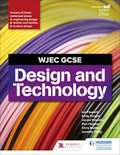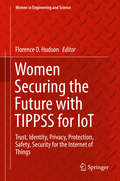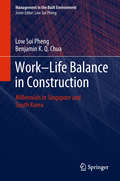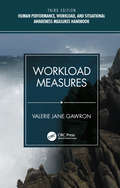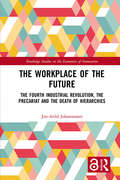- Table View
- List View
Wireless Powered Communication Networks: From Security Challenges to IoT Applications
by Abbas Jamalipour Ying BiThis textbook introduces Wireless Powered Communication Networks (WPCNs) as a promising paradigm to overcome the energy bottleneck suffered by traditional wireless communication networks, as well as emerging Internet-of-Things networks. It selectively spans a coherent spectrum of fundamental aspects in WPCNs, such as wireless energy transfer (WEH) techniques, radio frequency (RF) energy harvesting receiver model, simultaneous wireless information and power transfer (SWIPT), as well as the rate-energy tradeoff arising from the joint transmission of information and energy using the same waveform. It covers network models for WPCNs, including the baseline and dual-hop WPCN models and a variety of related extensions. This book further examines the key factors including throughput, fairness, and security that must be taken into account for impeccable operation of WPCNs. The new IoT applications are targeted as a key element in those factors. It will also include exercises and examples throughout the book, as well as their PLS solutions.This is the first textbook examining the current research to provide a unified view of wireless power transfer (WPT) and information transmission in WPCNs from a physical layer security (PLS) perspective. Focused on designing efficient secure transmission schemes, analyzing energy evolvement process, and evaluating secrecy outage performance under different channel state information (CSI), the results presented in this book shed light on how to best balance security and throughput with prudent use of harvested energy in WCNs. It also provides an overview of the WPCNs by introducing the background of WPT, followed by a summary of the research conducted in the field. The authors describe the physical-layer security (PLS) problem in WPCNs, including the causes and the impacts of the problem on the performance of WPCNs. The authors extend the discussions by introducing the applications of WPCNs in the IoT.From the Internet of Things (IoT) point of view, this textbook reviews the opportunities and challenges for the lately-emerged WPCN to seamlessly integrate into the IoT ecosystem. It specifically addresses the maximization problem of uplink and downlink sum-throughout in a dual-hop WPCN, while taking fairness among WPCN users as a constraint. The results provided in this book reveal valuable insights into improving the design and deployment of future WPCNs in the upcoming IoT environment.This textbook targets advanced-level students studying wireless communications and research engineers working in this field. Industry engineers in mobile device and network development business with an interest in WPCNs and IoT, as well as their PLS solutions, will also find this book useful.
Wirkungsgradoptimales ottomotorisches Konzept für einen Hybridantriebsstrang (Wissenschaftliche Reihe Fahrzeugtechnik Universität Stuttgart)
by Jing ChengJing Cheng untersucht simulativ den Magerbetrieb im P2-Hybridantriebsstrang. Dafür erstellt die Autorin ein Gesamtsystemmodell für genauere Simulationsergebnisse und entwickelt ein Verfahren zur Parametrisierung des Gesamtsystemmodells. Der Schwerpunkt ihrer Untersuchung liegt auf dem Verbrauchseinfluss. Eine regelbasierte und eine optimierte Hybridbetriebsstrategie (Equivalent Consumption Minimization Strategy, ECMS) werden in der Simulation eingesetzt. Die Autorin zeigt, dass sich der Optimierungsalgorithmus ECMS auch auf die Rohemissionen erweitern lässt.Die Autorin:Jing Cheng hat am Lehrstuhl für Fahrzeugantriebe des IVK an der Universität Stuttgart promoviert und ist aktuell Berechnungsingenieurin mit Schwerpunkt Gesamtsystemsimulation für die konventionellen und Hybridantriebsstränge bei einem deutschen Automobilkonzern.
Wirtschaftliche Unternehmensführung im Architektur- und Ingenieurbüro: Rechtsform – Personalpolitik – Controlling – Unternehmensplanung
by Dietmar GoldammerEine erfolgreiche Unternehmensführung zeichnet sich durch Rentabilität aus. Dieses Fachbuch beleuchtet die Faktoren, die eine erfolgreiche Unternehmensführung, speziell im Architektur- und Planungsbüro, bestimmen. Es gibt dem Büroinhaber Steuerungstools an die Hand, um auch auf lange Sicht den wirtschaftlichen Erfolg seines Unternehmens zu sichern.
Wirtschaftlichkeitsrechnung für Ingenieure: Grundlagen für die Entwicklung technischer Produkte
by Haiko SchlinkDieses Lehrbuch macht Studierende und Lehrende aller Ingenieurdisziplinen mit den für sie relevanten betriebswirtschaftlichen Grundlagen und Methoden vertraut. Da die Entwicklung neuer Produkte meist langwierig und mit hohem Geldeinsatz verbunden ist, wird es immer wichtiger, dass sich Ingenieure systematisch mit der Entscheidungsfindung auseinandersetzen. Andernfalls besteht die Gefahr, dass wichtige Dinge „aus dem Bauch heraus“ entschieden werden und wesentliche Vorstellungen des Unternehmens unberücksichtigt bleiben. Studierende, Lehrende und interessierte Praktiker erfahren, wie sie die Wirtschaftlichkeit von Produktentwicklungen oder -änderungen entwicklungsmethodisch nachhaltig verbessern.Neben anschaulichen Beispielen sind zur Einübung des Stoffes jedem Abschnitt Fragen zur Wiederholung und Vertiefung sowie Übungsaufgaben mit Lösungen zugeordnet. Für die 3. Auflage wurden insbesondere die Bereiche Kostenkalkulation, Produktentwicklung als Investition und betriebswirtschaftliche Entscheidungslehre gründlich überarbeitet und thematisch erweitert.Das Buch enthält ein Geleitwort von Univ.-Prof. em. Dr. habil. Herfried M. Schneider.
Witness X: A futuristic crime thriller guaranteed to keep you up all night
by SE Moorhead"Silence of the Lambs meets Blade Runner. A dark and gripping crime novel set in a convincing near future - SE Moorhead is the future of crime writing." STEPHEN BAXTER"Set in the near-future, Witenss X is an intelligent and highly inventive take on the traditional serial killer thriller." ASHLEY DYER, author of Splinter in the Blood From one of the most original new voices in fiction comes a startling vision of a world where hero Kyra must fight the past to save our future. A genre-bending thriller for the Netflix generation, for fans of Altered Carbon, Dark and Mindhunter.She's the only one who can access the truth...Fourteen years ago, the police caged a notorious serial killer who abducted and butchered two victims every February. He was safe behind bars. Wasn't he?But then another body is discovered, and soon enough, the race is on to catch the real killer. Neuropsychologist Kyra Sullivan fights to use a new technology that accesses the minds of the witnesses, working with the police to uncover the truth. Will Kyra discover the person behind the murders, and if so, at what cost? And how far will she go to ensure justice is served?An addictive futuristic thriller, perfect for fans of Stranger Things.
WJEC Eduqas GCSE (9-1) Design and Technology
by Ian Fawcett Jacqui Howells Dan Hughes Andy Knight Chris Walker Jennifer TilleyExam board: WJEC EduqasLevel: GCSESubject: Design & TechnologyFirst teaching: September 2017First exams: Summer 2019Reinforce classroom learning and boost students' understanding of all materials with this textbook written for the WJEC Eduqas GCSE (9-1) Design & Technology specification.Written by leading D&T experts, this textbook will build your students' knowledge of the core principles, help to develop their designing and making skills and provide them with the opportunity to make sure they are ready to tackle both parts of the assessment. - Helps students clearly understand the core principles of all materials and general concepts of designing and making, as well as build their knowledge, understanding and skills for one material or system in more depth- Hones students' mathematical and scientific ability so they don't miss out on the easy marks- Features practice questions in the style of the written exam to make sure students are confident to tackle the written element of the assessment- Inspires and motivates students with stretch and challenge: activities designed to challenge the more able learners and to ensure progression to A-level
WJEC GCSE Design and Technology
by Ian Fawcett Jacqui Howells Dan Hughes Andy Knight Chris Walker Jennifer TilleyExam board: WJECLevel: GCSESubject: Design and TechnologyFirst teaching: September 2017First exams: Summer 2019Reinforce classroom learning and boost students' understanding of their chosen area of design and technology with this textbook written for the WJEC GCSE Design & Technology specification for Wales.Written by leading D&T experts, this textbook will build your students' knowledge of the core principles, help to develop their designing and making skills and provide them with the opportunity to make sure they are ready to tackle both parts of the assessment. - Helps students clearly understand the core knowledge, understanding and skills and general concepts of designing and making, as well as build their knowledge, understanding and skills of either Engineering Design, Fashion and Textiles or Product Design in more depth- Hones students' mathematical and scientific ability so they don't miss out on the easy marks- Features practice questions in the style of the written exam to make sure students are confident to tackle the written element of the assessment- Inspires and motivates students with stretch and challenge: activities designed to challenge the more able learners and to ensure progression to A-level
WJEC GCSE Design And Technology (PDF)
by Ian Fawcett Jacqui Howells Dan Hughes Andy Knight Chris Walker Jennifer TilleyExam board: WJEC Level: GCSE Subject: Design and Technology First teaching: September 2017 First exams: Summer 2019 Reinforce classroom learning and boost students' understanding of their chosen area of design and technology with this textbook written for the WJEC GCSE Design & Technology specification for Wales. Written by leading D&T experts, this textbook will build your students' knowledge of the core principles, help to develop their designing and making skills and provide them with the opportunity to make sure they are ready to tackle both parts of the assessment. - Helps students clearly understand the core knowledge, understanding and skills and general concepts of designing and making, as well as build their knowledge, understanding and skills of either Engineering Design, Fashion and Textiles or Product Design in more depth - Hones students' mathematical and scientific ability so they don't miss out on the easy marks - Features practice questions in the style of the written exam to make sure students are confident to tackle the written element of the assessment - Inspires and motivates students with stretch and challenge: activities designed to challenge the more able learners and to ensure progression to A-level
Wohnquartiere mit einem Niedrig-Temperatur-Wärmenetz: Eine modellgestützte Analyse zentraler und dezentraler Energieversorgungssysteme (BestMasters)
by Vanessa HagedornVanessa Hagedorn untersucht in zwei städtebaulich unterschiedlichen Wohnquartieren den Einsatz von zentralen gegenüber dezentralen Energieversorgungssystemen, welche Technologien wie Photovoltaikanlagen, Quartiersbatteriespeicher, Kessel sowie ein Niedrig-Temperatur-Wärmenetz berücksichtigen. Anhand einer modellgestützten Analyse vergleicht die Autorin die zentralen und dezentralen Energieversorgungssysteme im Hinblick auf verschiedene Kriterien, wie ihre ökologischen und ökonomischen Aspekte, als auch in Bezug auf ihre Energieautarkie miteinander. Erstmalig werden dezentrale Energiesysteme auf Gebäude- und Quartiersebene simultan optimiert. Dies war bisher in vielen Modellen nur getrennt umsetzbar.
Women Securing the Future with TIPPSS for IoT: Trust, Identity, Privacy, Protection, Safety, Security for the Internet of Things (Women in Engineering and Science)
by Florence D. HudsonThis book provides insight and expert advice on the challenges of Trust, Identity, Privacy, Protection, Safety and Security (TIPPSS) for the growing Internet of Things (IoT) in our connected world. Contributors cover physical, legal, financial and reputational risk in connected products and services for citizens and institutions including industry, academia, scientific research, healthcare and smart cities. As an important part of the Women in Science and Engineering book series, the work highlights the contribution of women leaders in TIPPSS for IoT, inspiring women and men, girls and boys to enter and apply themselves to secure our future in an increasingly connected world. The book features contributions from prominent female engineers, scientists, business and technology leaders, policy and legal experts in IoT from academia, industry and government.Provides insight into women’s contributions to the field of Trust, Identity, Privacy, Protection, Safety and Security (TIPPSS) for IoTPresents information from academia, research, government and industry into advances, applications, and threats to the growing field of cybersecurity and IoTIncludes topics such as hacking of IoT devices and systems including healthcare devices, identity and access management, the issues of privacy and your civil rights, and more
Wording Robotics: Discourses and Representations on Robotics (Springer Tracts in Advanced Robotics #130)
by Jean-Paul Laumond Emmanuelle Danblon Céline PietersRobots challenge humans’ beliefs and expectations. Hence, regardless of whether they are the audience of a conference, the visitors of a lab, the citizens in general, some journalists, or the European Parliament, the first step in order to gain a better understanding of the field of robotics is obviously to consult the experts. Roboticists seem indeed to be in the best position to guide society in this matter, whether it is in the everyday life or within an official institution. Today however, there is a gap between the robots, as they are actually thought and built, and the intelligent and autonomous machines, as they are perceived by the society. How can we explain it? Do the words borrowed from the living organisms and used to describe robots play a role in the confusion about the status of the discipline of robotics? The texts gathered within this book focus on the problematic of wording robotics from various perspectives. They are the results of a unique interdisciplinary meeting gathering roboticists, linguists, philosophers and neuroscientists, the 4th Workshop of Anthropomorphic Motion Factory held at LAAS-CNRS in Toulouse on Nov 31st - Dec 1st 2017.
Work Activity Studies Within the Framework of Ergonomics, Psychology, and Economics (Human Activity)
by Gregory Z. Bedny Inna S. BednySystemic-structural activity theory (SSAT), founded by Gregory Bedny, is a relatively new unified framework for the study of efficiency of human performance, equipment, and software design. This book presents new recently obtained data in the field of SSAT that can be used in the study of efficiency and complexity of human performance. With increased cognitive demands to task performance, psychological methods of study of human activity play an important role. New principles and revised methods for the study of human work are supplemented by practical examples in manufacturing, construction industry, aviation, and human-computer interaction. Features: Presents new SSAT data Offers, for the first time, comparative analysis of studying efficiency and productivity from the perspective of ergonomics, psychology, and economics Includes examples of evaluation of economic efficiency of ergonomic innovations Provides advanced self-regulative models of activity and of all cognitive processes that describe strategies of task performance Introduces a new efficient method of morphological and analytical quantitative analysis Discusses new methods of evaluation of complexity and reliability of highly variable computerized and computer-based tasks Work Activity Studies Within the Framework of Ergonomics, Psychology, and Economics presents a comprehensive unified psychological theory that can be utilized as a general approach to the study of human activity not only for ergonomists and psychologists, but also for economists that study the efficiency of human performance.
Work Activity Studies Within the Framework of Ergonomics, Psychology, and Economics (Human Activity)
by Gregory Z. Bedny Inna S. BednySystemic-structural activity theory (SSAT), founded by Gregory Bedny, is a relatively new unified framework for the study of efficiency of human performance, equipment, and software design. This book presents new recently obtained data in the field of SSAT that can be used in the study of efficiency and complexity of human performance. With increased cognitive demands to task performance, psychological methods of study of human activity play an important role. New principles and revised methods for the study of human work are supplemented by practical examples in manufacturing, construction industry, aviation, and human-computer interaction. Features: Presents new SSAT data Offers, for the first time, comparative analysis of studying efficiency and productivity from the perspective of ergonomics, psychology, and economics Includes examples of evaluation of economic efficiency of ergonomic innovations Provides advanced self-regulative models of activity and of all cognitive processes that describe strategies of task performance Introduces a new efficient method of morphological and analytical quantitative analysis Discusses new methods of evaluation of complexity and reliability of highly variable computerized and computer-based tasks Work Activity Studies Within the Framework of Ergonomics, Psychology, and Economics presents a comprehensive unified psychological theory that can be utilized as a general approach to the study of human activity not only for ergonomists and psychologists, but also for economists that study the efficiency of human performance.
Work-Life Balance in Construction: Millennials in Singapore and South Korea (Management in the Built Environment)
by Low Sui Pheng Benjamin K. ChuaThe book presents the latest studies on the work–life balance of millennial (also known as Generation Y) building professionals in Singapore and South Korea. Its main goal is to compare and contrast the workplace attitudes of millennials, and to provide guidelines that help supervisors in the construction industry manage their employees’ expectations regarding work–life balance. Accordingly, it explains and links various principles regarding work–life conflicts, work–life enrichments and the work–life interface. Furthermore, the book introduces readers to coping strategies, a dimension that has not yet been explored substantially and has the potential to contribute significantly to the study and understanding of work–life balance. The book makes recommendations for the top management on assigning a capable leader to drive the changes in the organization, and on empowering the leader to implement effective strategies for promoting work–life balance, especially for the millennials who are now playing an increasing central role in the global construction sector.
Workbook for Sectional Anatomy for Imaging Professionals E-Book
by Lorrie L. KelleyBetter understand and retain the material in Kelley’s Sectional Anatomy for Imaging Professionals, 4th Edition with this dynamic workbook. With its wide variety of engaging exercises — including illustration labeling, puzzles, case studies, matching activities, fill-in-the-blank questions, short-answer questions, and more — you can benefit from an integrated and highly-visual approach to learning sectional anatomy and its application in diagnostic imaging.Wide variety of engaging exercises — including matching, true/false, fill-in-the-blank, case studies, and labeling — aid your learning and retention. Chapter objectives focus your attention on the important concepts you are expected to master by the end of the chapter.Memory learning aids help you quickly memorize terms, definitions, and anatomic locations so you can concentrate more on the application of concepts.Over 300 images with labeling opportunities provide thorough practice in identifying anatomic structures.NEW! Updated material corresponds with the updated material in the main text.NEW! Additional labeling queries reinforce identification of structures on sectional anatomy images.NEW! Additional exercises further emphasize anatomic location and function.NEW! Additional case studies help tie the material to what happens on the job in the clinical setting.
Working Across Boundaries: Resilient Health Care, Volume 5
by Jeffrey Braithwaite Erik Hollnagel Garth S HunteThe book demonstrates how Resilient Health Care principles can enable those on the frontline to work more effectively towards interdisciplinary care by gaining a deeper understanding of the boundaries that exist in everyday clinical settings. This is done by presenting a set of case studies, theoretical chapters and applications that relate experiences, bring forth ideas and illustrate practical solutions. The chapters address many different issues such as resolving conflict, overcoming barriers to patient-flow management, and building connections through negotiation. They represent a range of approaches, rather than a single way of solving the practical problems, and have been written to serve both a scientific and an andragogical purpose. Working Across Boundaries is primarily aimed at people who are directly involved in the running and improvement of health care systems, providing them with practical guidance. It will also be of direct interest to health care professionals in clinical and managerial positions as well as researchers. Presents the latest work of the lauded Resilient Health Care Net group, developing applications of Resilience Engineering to health care, furthering safety thinking and generating applicable solutions that will benefit patient safety worldwide Enables health care professionals to become aware of the boundaries that affect their work so that they are able to use their strengths and overcome their weaknesses Written from a Safety-II perspective, where the purpose is to make sure that as much as possible goes well and the focus therefore is on everyday work rather than on failures. There are at present no other books that adopt this perspective nor which go into the practical details Provides a concise presentation of the state of resilient health care as a science, in terms of major theoretical issues and practical methods and techniques on the overarching and important topics of boundary-crossing and integration of care settings
Working Across Boundaries: Resilient Health Care, Volume 5
by Jeffrey Braithwaite Erik Hollnagel Garth S HunteThe book demonstrates how Resilient Health Care principles can enable those on the frontline to work more effectively towards interdisciplinary care by gaining a deeper understanding of the boundaries that exist in everyday clinical settings. This is done by presenting a set of case studies, theoretical chapters and applications that relate experiences, bring forth ideas and illustrate practical solutions. The chapters address many different issues such as resolving conflict, overcoming barriers to patient-flow management, and building connections through negotiation. They represent a range of approaches, rather than a single way of solving the practical problems, and have been written to serve both a scientific and an andragogical purpose. Working Across Boundaries is primarily aimed at people who are directly involved in the running and improvement of health care systems, providing them with practical guidance. It will also be of direct interest to health care professionals in clinical and managerial positions as well as researchers. Presents the latest work of the lauded Resilient Health Care Net group, developing applications of Resilience Engineering to health care, furthering safety thinking and generating applicable solutions that will benefit patient safety worldwide Enables health care professionals to become aware of the boundaries that affect their work so that they are able to use their strengths and overcome their weaknesses Written from a Safety-II perspective, where the purpose is to make sure that as much as possible goes well and the focus therefore is on everyday work rather than on failures. There are at present no other books that adopt this perspective nor which go into the practical details Provides a concise presentation of the state of resilient health care as a science, in terms of major theoretical issues and practical methods and techniques on the overarching and important topics of boundary-crossing and integration of care settings
A Working Life: A True Story
by A. F. LodgeWork didn't necessarily define A. F. Lodge’s, but his career in chemical engineering saw him live a wonderfully rich and fascinating life. In this busy and informative memoir, Lodge not only sums up the total of his experience but elaborates on the excitement and satisfaction of an amazing journey; gratification that money can't buy. With a keen wit and raconteur's ability to entertain, Lodge leads us on a story through changing times and a variety of projects that saw him travel all over the world. With anecdotes flying across the pages underscoring culture as much as the intricacies of engineering projects, the author affords himself space to comment on more than just the work aspects. A travel compendium, autobiography and crash course on the evolution of the chemical engineering sector, Lodge has given us something eminently readable while he spends his retirement keeping active and reminiscing about A Working Life well spent.
Working Posture Assessment: The TACOS (Time-Based Assessment Computerized Strategy) Method (Ergonomics Design & Mgmt. Theory & Applications)
by Daniela Colombini Enrico OcchipintiThis book covers how to analyze awkward working postures, particularly of the spine and lower limbs, in specific groups exposed. The methods covered suggests how to evaluate the postures correctly, taking account of the duration and sequence of the tasks involved, even in very complex scenarios where workers are involved with multiple tasks and work cycles varying from day to day. Excel spreadsheets located on the authors’ website (www.epmresearch.org) have been developed to gather, condense, and automatically process the data. The tools serve to implement the strategy for calculating risk associated with exposure to awkward postures, i.e. the TACOS method. Included are 5 case studies which include physiotherapists, workers from construction, archaeological digs, vineyards, and kindergarten teachers. Features Provides a coherent definition of what the study of awkward postures is Clarifies and explains which parameters need to be detected and analyzed for the study of the working postures Defines the phases of a proper organizational study (e.g. tasks, postures, duration, and how often the postures will last) in the working cycle Presents a new and original risk calculation model for awkward postures, with particular attention to the study of the spine and the lower limbs Offers a free excel spreadsheet located on the authors' website which implements the strategy for calculating risk associated with exposure to awkward postures
Working Posture Assessment: The TACOS (Time-Based Assessment Computerized Strategy) Method (Ergonomics Design & Mgmt. Theory & Applications)
by Daniela Colombini Enrico OcchipintiThis book covers how to analyze awkward working postures, particularly of the spine and lower limbs, in specific groups exposed. The methods covered suggests how to evaluate the postures correctly, taking account of the duration and sequence of the tasks involved, even in very complex scenarios where workers are involved with multiple tasks and work cycles varying from day to day. Excel spreadsheets located on the authors’ website (www.epmresearch.org) have been developed to gather, condense, and automatically process the data. The tools serve to implement the strategy for calculating risk associated with exposure to awkward postures, i.e. the TACOS method. Included are 5 case studies which include physiotherapists, workers from construction, archaeological digs, vineyards, and kindergarten teachers. Features Provides a coherent definition of what the study of awkward postures is Clarifies and explains which parameters need to be detected and analyzed for the study of the working postures Defines the phases of a proper organizational study (e.g. tasks, postures, duration, and how often the postures will last) in the working cycle Presents a new and original risk calculation model for awkward postures, with particular attention to the study of the spine and the lower limbs Offers a free excel spreadsheet located on the authors' website which implements the strategy for calculating risk associated with exposure to awkward postures
Working with Map Projections: A Guide to their Selection
by Fritz Kessler Sarah BattersbyA map projection fundamentally impacts the mapmaking process. Working with Map Projections: A Guide to Their Selection explains why, for any given map, there isn’t a single "best" map projection. Selecting a projection is a matter of understanding the compromises and consequences of showing a 3-D space in two dimensions. The book presents a clear understanding of the processes necessary to make logical decisions on selecting an appropriate map projection for a given data set. The authors discuss the logic needed in the selection process, describe why certain decisions should be made, and explain the consequences of any inappropriate decision made during the selection process. This book also explains how the map projection will impact the map’s ability to fulfill its purpose, uses real-world data sets as the basis for the selection of an appropriate map projection, and provides illustrations of an appropriately and inappropriately selected map projection for a given data set. The authors take a novel approach to discussing map projections by avoiding an extensive inventory of mathematical formulae and using only the mathematics of map projections that matter for many mapping tasks. They also present information that is directly applicable to the process of selecting map projections and not tied to a specific software package. Written by two leading experts, this book is an invaluable resource for anyone studying or working with geospatial data, from students to experienced professionals, and will help readers successfully weigh the pros and cons of choosing one projection over another to suit a map’s intended purpose.
Working with Map Projections: A Guide to their Selection
by Fritz Kessler Sarah BattersbyA map projection fundamentally impacts the mapmaking process. Working with Map Projections: A Guide to Their Selection explains why, for any given map, there isn’t a single "best" map projection. Selecting a projection is a matter of understanding the compromises and consequences of showing a 3-D space in two dimensions. The book presents a clear understanding of the processes necessary to make logical decisions on selecting an appropriate map projection for a given data set. The authors discuss the logic needed in the selection process, describe why certain decisions should be made, and explain the consequences of any inappropriate decision made during the selection process. This book also explains how the map projection will impact the map’s ability to fulfill its purpose, uses real-world data sets as the basis for the selection of an appropriate map projection, and provides illustrations of an appropriately and inappropriately selected map projection for a given data set. The authors take a novel approach to discussing map projections by avoiding an extensive inventory of mathematical formulae and using only the mathematics of map projections that matter for many mapping tasks. They also present information that is directly applicable to the process of selecting map projections and not tied to a specific software package. Written by two leading experts, this book is an invaluable resource for anyone studying or working with geospatial data, from students to experienced professionals, and will help readers successfully weigh the pros and cons of choosing one projection over another to suit a map’s intended purpose.
Workload Measures
by Valerie Jane GawronThis book was developed to help researchers and practitioners select measures to be used in the evaluation of human/machine systems. The book includes definitions of human workload and a review of measures. Each measure is described, along with its strengths and limitations, data requirements, threshold values, and sources of further information. To make this reference easier to use, extensive author and subject indices are provided. Features Offers readily accessible information on workload measures Presents general description of the measure Covers data collection, reduction, and analysis requirements Details the strengths and limitations or restrictions of each measure, including proprietary rights or restrictions Provides validity and reliability data as available
Workload Measures
by Valerie Jane GawronThis book was developed to help researchers and practitioners select measures to be used in the evaluation of human/machine systems. The book includes definitions of human workload and a review of measures. Each measure is described, along with its strengths and limitations, data requirements, threshold values, and sources of further information. To make this reference easier to use, extensive author and subject indices are provided. Features Offers readily accessible information on workload measures Presents general description of the measure Covers data collection, reduction, and analysis requirements Details the strengths and limitations or restrictions of each measure, including proprietary rights or restrictions Provides validity and reliability data as available
The Workplace of the Future: The Fourth Industrial Revolution, the Precariat and the Death of Hierarchies (Routledge Studies in the Economics of Innovation)
by Jon-Arild JohannessenThe Fourth Industrial Revolution is a global development that shows no signs of slowing down. In his book, The Workplace of the Future: The Fourth Industrial Revolution, the Precariat and the Death of Hierarchies, Jon-Arild Johannessen sets a chilling vision of how robots and artificial intelligence will completely disrupt and transform working life. The author contests that once the dust has settled from the Fourth Industrial Revolution, workplaces and professions will be unrecognizable and we will see the rise of a new social class: the precariat. We will live side by side with the 'working poor' – people who have several jobs, but still can’t make ends meet. There will be a small salaried elite consisting of innovation and knowledge workers. Slightly further into the future, there will be a major transformation in professional environments. Johannessen also presents a typology for the precariat, the uncertain work that is created and develops a framework for the working poor, as well as for future innovation and knowledge workers, and sets out a new structure for the social hierarchy. A fascinating and thought-provoking insight into the impact of the Fourth Industrial Revolution, The Workplace of the Future will be of interest to professionals and academics alike. The book is particularly suited to academic courses in management, economy, political science and social sciences.
